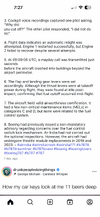I'm probably below average at figuring out what's going on in this hoopty, much less a 787, but I'd think that if the engines both started spooling down on takeoff, my first assumption would not be the fuel levers being cut. I don't know *what* my first assumption would be, but a pilot doing that would be so unfathomable to me, I don't know if it would cross my mind until I had a moment to process and look (at which point I'd actually see them in cutout rather than just assuming). Dunno, maybe that's just me though.
Not being familiar at all with this type (other than the fact that our start levers look the same), is there anything that would feel similar in a similar location that would be part of some normal flow? I know folks have shut HYD 2 off in the guppy when they thought they were turning the engine heaters off. I'm feeling like there is nothing comparable in that location of the cockpit, or during that phase of flight, but I don't know what I don't know.

